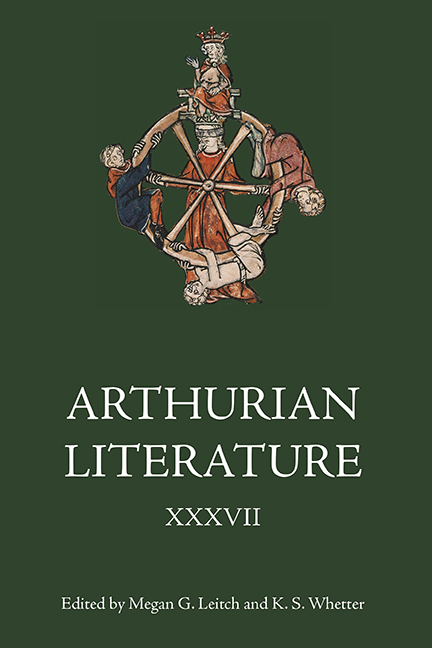Book contents
- Frontmatter
- Contents
- List of Charts and Tables
- Professor Fiona Tolhurst (1968–2021)
- General Editors’ Preface
- List of Contributors
- List of Abbreviations
- Introduction: The Tournament at Mapplemalleoré: Malory at 550
- 1 Malory and the Stock Phrase
- 2 The Artistry of Malory’s Mercantile Metaphors: Goods, Generosity, and the Source of ‘The Tale of Sir Gareth’
- 3 ‘A grete bourder and a passynge good knyght’: Sir Dinadan: ‘Gareth with a Twist’
- 4 Moonlight in the Nocturnal Typology of Malory’s Morte Darthur
- 5 ‘That shall nat ye know for me as at thys tyme’: Cognitive Narratology and Filling Malory’s Gaps
- 6 ‘On a tyme’: Action and Temporality in Malory’s ‘Sankgreal’
- 7 Hospitality in Malory
- 8 The Haunting of the Orkneys and Malory’s Arthurian Project
- 9 ‘I love nat to be constreyned to love’: Launcelot and Coerced Sex
- 10 Eradicating Victorian Backreading: Re-reading Malory’s Gwenyvere through Gaynour and Isode
- contents of previous volumes
1 - Malory and the Stock Phrase
Published online by Cambridge University Press: 15 September 2022
- Frontmatter
- Contents
- List of Charts and Tables
- Professor Fiona Tolhurst (1968–2021)
- General Editors’ Preface
- List of Contributors
- List of Abbreviations
- Introduction: The Tournament at Mapplemalleoré: Malory at 550
- 1 Malory and the Stock Phrase
- 2 The Artistry of Malory’s Mercantile Metaphors: Goods, Generosity, and the Source of ‘The Tale of Sir Gareth’
- 3 ‘A grete bourder and a passynge good knyght’: Sir Dinadan: ‘Gareth with a Twist’
- 4 Moonlight in the Nocturnal Typology of Malory’s Morte Darthur
- 5 ‘That shall nat ye know for me as at thys tyme’: Cognitive Narratology and Filling Malory’s Gaps
- 6 ‘On a tyme’: Action and Temporality in Malory’s ‘Sankgreal’
- 7 Hospitality in Malory
- 8 The Haunting of the Orkneys and Malory’s Arthurian Project
- 9 ‘I love nat to be constreyned to love’: Launcelot and Coerced Sex
- 10 Eradicating Victorian Backreading: Re-reading Malory’s Gwenyvere through Gaynour and Isode
- contents of previous volumes
Summary
The Boss: ‘The truth is, Alisande, these archaics are a little too simple; the vocabulary is too limited, and so, by consequence, descriptions suffer in the matter of variety; … this throws about them a certain air of the monotonous’.
– Mark Twain, A Connecticut Yankee in King Arthur's CourtMark Twain first encountered Sir Thomas Malory's Morte Darthur in 1884, in a Rochester bookstore. It ‘is the quaintest and sweetest of all books’, he wrote his daughter later that year, and he told a friend in 1906 that it was ‘one of the most beautiful things ever written in English’. In 1888 Twain included Malory in a list of his nine favorite authors. At the same time, in his Connecticut Yankee (published 1889), Twain had a lot of fun parodying Malory's ‘limited’ and ‘monotonous’ vocabulary.
Mark Twain is not the only commentator to have fallen into self-contradiction after reading Malory's Morte. In literary analysis, Malory's stock phrases have often been dismissed as stale and repetitive. A. C. Baugh, for example, described them as ‘the innumerable formulas and commonplaces – knights stiff in strife, ladies white as foam, swords that well could bite … [that were] common to every author of a mediaeval romance. They were in every one's ears, known to every one who heard romances read or recited. Chaucer knew them well enough to satirize them’. Having noted that stock phrases common in English romance show up also in the Paston letters, P. J. C. Field concluded that the phrases were part of the vernacular of the day and that Malory used them as the ‘readiest and easiest way’ to tell his story.
At the same time, like Twain, scholars have acknowledged the beauty of Malory's prose. Field has commented, for example, that Malory's style ‘is the result of a complex of elements too heterogeneous and irregular in their combination to be the results of conscious art; but the careless yet subtle amalgam into which its elements have been fused will bear comparison with the greatest and most distinctive styles in English prose’.
How can a book be so great if its language is endlessly repetitive and lacks conscious art? The answer involves a closer look at how Malory deploys his stock phrases – a look that will reveal a system behind this repetitiveness that drives much of the book's impact.
- Type
- Chapter
- Information
- Arthurian Literature XXXVIIMalory at 550: Old and New, pp. 7 - 22Publisher: Boydell & BrewerPrint publication year: 2022



